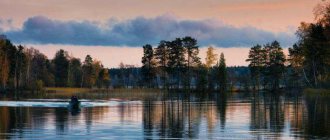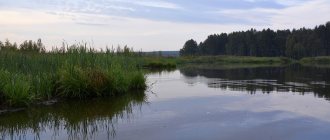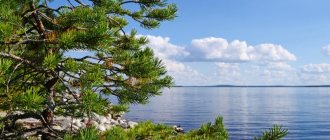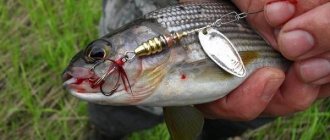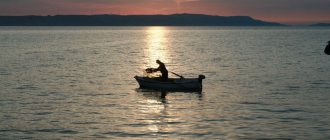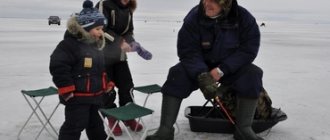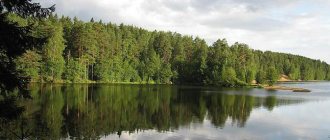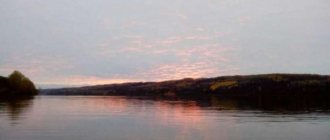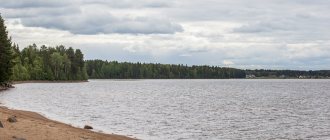Origin of the hydronym
There are two versions of the origin of the name of this lake. The first version tells about the Evenki roots of the hydronym. Since the 17th century, the Evenk name – “Arakley” – has been used. Etymology unknown. In the Buryat version it was transformed into “Arakhlei”. This name stuck and still exists today. According to an alternative version, the hydronym comes from the Buryat language. Today, locals call the lake Arakhelenur. The particle “hel” is often found in Buryat place names and means “small place”, and “Ara” means “back side”. Thus, the name “Arakhlei” should perhaps be understood as “northern shallow lake”.
Characteristics of the reservoir
Arakhlei is a fairly large lake. Its surface area is 58.5 km2. The reservoir is 10 km long and 7 km wide (approximately). The volume of water is 0.61 km³. The greatest depth is about 19 m.
Lake Arakhlei has a fairly diverse flora. 27 plant species are registered there. As for the fauna, 15 species of fish have been recorded in the water area. Among them are perch, bream, crucian carp, roach, pike, dace, catfish, etc.
One of the features of the reservoir is very clear water. In calm weather with light winds, a depth of up to 4 meters can be seen. Arakhlei is part of the Ivano-Arakhlei State Natural Landscape Reserve. Two villages are located near the lake - Preobrazhenka and Tasei.
How to get to the lake?
From Chita you can get to Arakhlei by car along the P436 highway. The final destination will be the village of Tasey. Travel time will be a little over an hour. At the end, lakes begin to appear along the way. The first of them is Tasei, the second is Ivan. Upon arrival in the village of Tasey, you can go to Lake Arakhley, which is located about 2 km from the village.
You can also get to the reservoir by bus No. 219, which goes from Chita to Beklemishevo. The route runs through all the settlements around the lake: Tasey, Peski, Preobrazhenka. You can land in any of them, depending on which side you need to get to a body of water such as Lake Arakhlei. Recreation centers are located in all nearby areas.
You should definitely visit these places and enjoy your holiday on this body of water. All tourists leave only positive reviews and cannot get enough of a good time.
Fishing
Many avid fishermen come to Lake Arakhlei in the hope of a rich catch. Shore fishing and spearfishing are popular here. The most common fish is perch. It is good to catch it with a worm in the summer. Silicone nozzles and “spinners” are also suitable. During the winter months, a drill (local name for a jig) is a very good bait for fishing. April is the time when roach and dace gather in huge spawning schools. Fishermen are guaranteed a large catch until mid-May.
Summer fishing
Tips for fishing lovers in Transbaikalia
Summer is the time of the most widespread amateur fishing, when, perhaps, there is not a single body of water that is not noted by fishermen of all ages, and sometimes regardless of the species of fish living in the reservoir, and its presence there in general.
The most visited bodies of water in the summer can definitely be called the Ivano-Arakhlei Lakes. The ichthyofauna in the lakes is diverse, and when going fishing, you can ask yourself the question - what kind of fish do I want to catch?
Tasey
In recent years, a decent herd of crucian carp has formed, which will be good to catch almost the entire summer season, both from the shore, and “in a wade,” and from a boat.
Ivan
The roach has grown and can be caught from the shore. It is advisable to choose the eastern part of the lake - there are fewer thickets of grass and it is deeper. Ivan also has a high density of medium-sized pike, so you can enjoy spinning. But it’s unlikely to be possible to fish on the “path” - due to the general lack of water, vegetation in all lakes, unfortunately, has been abundant in recent years.
Arakhlei
Traditionally, a perch-pike reservoir has gradually turned into a perch-roach-pike reservoir, but by choosing the right gear and bait, you can set yourself up for fishing either perch or roach - whichever you like. Pike density is low, so spinning will bring luck only to the most persistent and lucky ones.
Shaksha
This summer, unfortunately, will not please anglers with good catches. The reason is that the perch is mostly small, roach will be caught only in the first half of summer, and pike fishing will be difficult due to the heavy overgrowth of the lake.
Irgen
Less accessible to fishermen due to its remoteness, but in recent years the number of fishermen on its banks has been growing. This summer it will be possible to catch good perch on the Irgen, and it is advisable to choose the confluence of the channel connecting Irgen with Khilk - the constantly migrating perch in search of new food will “take” almost any bait. Pike in Irgen is also a fairly common species, so when going to Irgen this summer, take a spinning rod and check all the old and new spoons and wobblers - you should be lucky.
Undugun
The last of the large lakes of the Ivano-Arakhlei group, Undugun, never brings a significant catch to amateur fishermen in the summer. It is most often chosen because of its wooded banks, which create a feeling of enclosure. The number of pike in Undugun has not yet recovered after the last kill, so you can’t count on catching one. And you can rarely get a good bite of perch; as they say, it’s 50/50. In general, fishing is more “for the soul.”
Ingoda, Onon, Shilka
These rivers and their tributaries will not bring large catches to anyone this summer. The main reason is the lack of water in the last decade and the insufficient reproduction of most river species. But probably not a single fisherman will be left without a catch. Beginning fishermen (and not only beginners) fish to their hearts’ content for minnows and minnows, whose taste qualities, by the way, are superior to many other fish.
In the lower reaches of the tributaries, as the water warms up, the main catch will consist of chebak; cold-loving grayling and lenok will rise to the upper reaches, where more experienced fishermen who know what kind of fish they want to catch will reach. The numbers of both lenok and grayling depend significantly on water availability, especially in the spring, and therefore their numbers have been reduced in recent years. The current state of the abundance of these species requires the introduction of restrictions on the export of catches from the reservoir, up to a complete ban on the procurement of this fish for future use. Moreover, perhaps only a small number of fishermen succeed in preserving and bringing grayling and lenok home in the summer.
Have a nice summer holiday and good luck to you!
Ksenia GILFANOVA
With the assistance of the boss
Transbaikal territorial department of Angaro-Baikal
territorial administration
Rosrybolovstvo - Loginova K.A.
Our recommendations
And, perhaps, the most important recommendations - so that your fishing holiday is not ruined, you need to follow several basic rules: just in case, put printed “Fishing Rules for the Baikal Fishery Basin” in your glove compartment (easy to find on the Internet); prohibited fishing gear - nets, dragnets, prisons, and others listed in the “Fishing Rules...” You should not have it with you, even in the trunk of your car. Park the car outside the coastal protective strip of the reservoir (50 m) - this is determined by the Water Code of the Russian Federation.
Recreation center "Pristan"
Open 365 days a year. Located in the "Bolvanka" area. For visitors, heated houses are organized here: 2 for 4 places and a large building divided into 2 rooms. Each living space has refrigerators, electric stoves, electric kettles, washbasins, and wood-burning stoves.
Visitors to the base can go sunbathe on the beach, where there are sun loungers, beach umbrellas, a fire pit and barbecues. You can also rent a boat or catamaran there. A summer cafe is open to visitors. Children can spend time on the playground. Guests of the camp site spend time playing various games, for example, table tennis, billiards, and air hockey.
Source
Transbaikal fishing: where is the best bite?
The best fishing spots in the Trans-Baikal Territory
If the world of fishermen had its own geographical maps, then the Trans-Baikal Territory
would be called paradise in them. It is here, on vast territories, that even the most fastidious will find their places for fishing: here is a network of lakes not far from Chita, and the steppe southeast, where the soldiers of Genghis Khan once found food, and the harsh, but infinitely generous for fatty and large fish north.
Ivano-Arakhlei Lakes
Not far from the regional center, the city of Chita, just about an hour and a half leisurely drive along the road, which was recently repaired, lies the Ivano-Arakhlei system of lakes
, connected by dozens of springs to Lake Baikal and two lakes,
Tasey
and
Ivan
, to the Lena River basin.
Six lakes with a total water area of 10 square kilometers are located in the basin between the picturesque Osinov and Yablonov ridges to the west of Chita.
The most impatient fishing lovers are greeted by Lake Ivan
and the village of the same name on the shore.
Having made your way through the reeds in wading boots, you can lose track of time on the shore or in a boat, and then cook fish soup in a pot with someone who is in the same sect of fishing lovers as you. On weekends there are many guests from Chita on Ivan
. If you want privacy, come on weekdays or drive further.
Regions of the Russian Federation
There are a lot of territorial districts in the Russian Federation, so our administration has divided them for the convenience of users. Now each visitor will be able to select his own area, and then look at a map of the most catchable water bodies and get acquainted with the species composition of the ichthyofauna.
Republic
- Republic of Adygea;
- Altai Republic;
- Republic of Bashkortostan;
- The Republic of Buryatia;
- The Republic of Dagestan;
- The Republic of Ingushetia;
- Republic of Kabardino-Balkaria;
- Republic of Kalmykia;
- Republic of Karachay-Cherkessia;
- Republic of Karelia;
- Komi Republic;
- Mari El Republic;
- The Republic of Sakha (Yakutia);
- Republic of North Ossetia - Alania;
- Republic of Tatarstan;
- Republic of Udmurtia;
- The Republic of Khakassia;
- Republic of Chechnya;
- Chuvash Republic;
edge
- Altai region;
- Transbaikal region;
- Kamchatka Krai;
- Krasnodar region;
- Krasnoyarsk region;
- Perm region;
- Primorsky Krai;
- Stavropol region;
- Khabarovsk region;
Region
- Amur region;
- Arhangelsk region;
- Astrakhan region;
- Belgorod region;
- Bryansk region;
- Vladimir region;
- Volgograd region;
- Vologda Region;
- Voronezh region;
- Ivanovo region;
- Irkutsk region;
- Kaliningrad region;
- Kaluga region;
- Kemerovo region;
- Kirov region;
- Kostroma region;
- Kurgan region;
- Kursk region;
- Leningrad region;
- Lipetsk region;
- Magadan Region;
- Moscow region;
- Murmansk region;
- Nizhny Novgorod Region;
- Novgorod region;
- Novosibirsk region;
- Omsk region;
- Orenburg region;
- Oryol Region;
- Penza region;
- Pskov region;
- Rostov region;
- Ryazan Oblast;
- Samara Region;
- Saratov region;
- Sakhalin region;
- Sverdlovsk region;
- Smolensk region;
- Tambov Region;
- Tver region;
- Tomsk region;
- Tula region;
- Tyumen region;
- Ulyanovsk region;
- Chelyabinsk region;
This is interesting: Rubskoe Lake: fishing and what kind of fish is found
About ice fishing on Lake Arakhley (Chita region)
Winter fishing for perch on Arakhleya by non-residents
There are two approaches, more precisely, styles of perch fishing on Arakhlei. Nonresidents practice traditional ice fishing, but in a Transbaikal version. Its three most important components are the choice of gear, the method of feeding and the search for perch sites.
The tackle is a winter fishing rod for fishing with a jig, on the hook of which a drill is attached. Fish are caught with it from the bottom.
No-attachment tackle is used either by beginners or by “theorists” who put means above goals and experience special pleasure from a “clean” victory over the enemy.
Local fishermen for the most part are conservatives and disdain “no-bait” baits, believing that they don’t seek goodness from goodness: if you catch it with a drill, why waste time experimenting with cambrics?
Fishing rods look structurally differently. In the spring, when the ice gets warmer, the so-called “balalaika” is widely used, which is very convenient for playing with a jig with a high vibration frequency and for vertical retrieving to a height of up to 1 m. In the pre-winter period and on frosty days, when fishermen pull mittens on their hands, Fishing rods with handles of various lengths are in use.
In the spring, when the chebak bite picks up, some fishermen fish with float gear; white fish fish better on them. The attachment is still the same - drill.
The designs of jigs and nods are very different. And of course, every angler considers the gear he makes to be the best, which simply cannot be equaled.
It’s very rare to see “devilish” masters here. For such fishing you need to master specific fishing, only then you will have a catch. But the ease of catching perch with a regular jig with a drill and its relatively high catchability force fishermen to abandon not only “devils”, but also spinners.
So, the basis of the traditional style of fishing is playing with a jig at the bottom. The perch is fed with live drill (Fig. 1) using a feeder. Having placed it on the bottom, lift it to a height of 70-80 cm from the bottom, and jerk it open. The crustaceans, moving in the water like a swarm of bees, form a cloud hovering over the jig and attracting perch (Fig. 1, a). If you open the feeder at the bottom or near it, the drills will scatter along the cracks in the stones and bottom pebbles, like cockroaches, and, naturally, will not attract fish (Fig. 1, b).
Rice. 1. Options for feeding with a drill: a - the feeder opens above the bottom; b - the feeder opens at the bottom; c - crustaceans pour directly into the hole; 1 - jig with drill; 2 — bait drill; 3 - feeder.
Throwing crustaceans into the hole will be even less successful. The drills, having passed the water trunk of the hole, hover at the lower edge of the ice, slowly descending and making chaotic movements. This “running around” attracts fish, pulling it from the bottom, and in the meantime the fisherman diligently shakes the jig and knocks it on the bottom from scratch (Fig. 1.c).
Finding perch spots for fans of the classic style is as simple as possible: in Arakhlei perch not only dominates, there is simply a lot of it in the lake. Having drilled holes anywhere, you could already be sure that you would not be left without fish.
What kind of fish is found on Lake Arakhlei
The most common fish on the lake is perch. You can also find pike, roach (chebak), dace, minnow, Amur carp, catfish, burbot and sculpin goby. Arakhlei perch has its own characteristics. His hump is less developed than usual. The color is light with a steel tint. The stripes on the body are paler than usual, which is associated with high water transparency and an abundance of hard sunlight. Most often there are individuals weighing from 150 to 300 grams, which are well caught with a fishing rod. The maximum weight of a perch is 1 kg, the minimum is 20 g. Small specimens are found less frequently than in European reservoirs.
In terms of the composition of water and fauna, Lake Arakhlei is in many ways reminiscent of nearby Baikal. Its size and depth, of course, are smaller, and this is an obstacle to the reproduction of fish such as grayling and omul. But young omul and peled are released into the lake artificially and within a few years reach the size of adult fish.
Lake Arakhlei
Of course, most fishermen in Transbaikalia know about the seasonal movement of roach and dace. The course of leucorrhoea begins approximately in mid-April. Around the time when the first shores appear on the lake. But finding the coveted school and thereby dooming yourself to a machine-gun fish bite is very difficult. Roach and dace do not stay in one place for a long time; the fish constantly cruises along the coast of Arakhlei. Try to guess where she will start feeding today.
- Sergey, hello, how are things at the lake, is he doing laundry? – asks Alexander, my fishing buddy.
– Sash, have you ever been to Moscow? Did you walk along Tverskaya? So, there are about the same number of people on Arakhlea today! – I answer him on my mobile phone. I couldn’t say anything definite about the bite yet, since at the time of our conversation I had only just set foot on the spring ice of Arakhlei.
Despite the May warmth and the flies and butterflies circling around, the ice thickness is still more than one and a half meters, and there is nothing to fear. True, now water appears in the hole after the ice drill passes the one-meter mark. The remaining ice has to be drilled, as they say, wet.
The first hole is closer to the shore, retreating from the line of sitting fishermen about five meters. The water under the ice is thirty centimeters. I throw a handful of drill and some ground crackers into the hole for smell and turbidity. I equip the fishing rod with a yellow tungsten jig with artificial bloodworms and begin to slowly lower the bait from the lower edge of the ice to the bottom. A minute later there is a sharp bite, and it’s clearly not white, and a 70 gram perch emerges from the hole. “So, it seems that history with minnows and minnows is about to repeat itself!” - I scare myself, looking at the striped robber and remembering the recent hunt for grayling and lenok on the Chita River (see “RR” No. 17). I look around at the fishermen in the hope of seeing a roach or dace caught. But in vain. The people were divided into two groups: some fishermen sat motionless over the holes, others walked around the lake and observed how things were going for the first ones.
Sasha’s arrival at the lake brought some confidence in the success of the upcoming fishing. “What, you never finished stitching? Yesterday it was the same nonsense. I only started taking it in the evening,” Alexander reassured me. He walked among the fishermen, looked at the catches, and asked how and what. After collecting information, he got into the car with the words “If I find fish, I’ll call you” and drove off.
I would like to tell you a little more about Alexander. He is a fisherman, so to speak, in law, a thoughtful, persistent searcher. He feels the fish. “I see them with my heart!” - Poligraf Poligrafovich said to his colleagues in catching basement cats. Perhaps the comparison is not entirely successful, but it is accurate. More than once I got the impression that Sasha sees fish in approximately the same way as a fish sees objects invisible to its eye using the lateral line. But Sasha cannot have a sideline, but his fishing intuition is perfectly developed. Multiplied by many years of experience and knowledge.
An hour and a half later my cell phone rang:
“Fish under Lake Karasev, the approaches are very careful, but there are no small things,” Alexander briefly reported.
The trigonometric point, or to put it simply, a tower made of logs, is located to the left of the village of Arakhlei, and Karasevoye Lake is on the right side. This is a small body of water, a satellite lake. The distance between the tower and the lake is five kilometers. Having received information from a source that I am inclined to trust, I pack up and go in the indicated direction.

